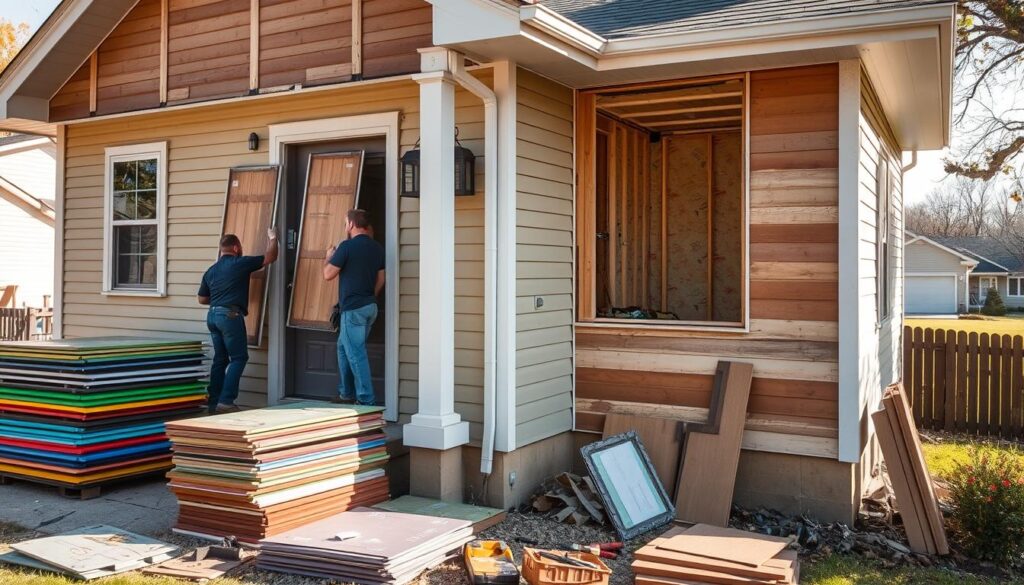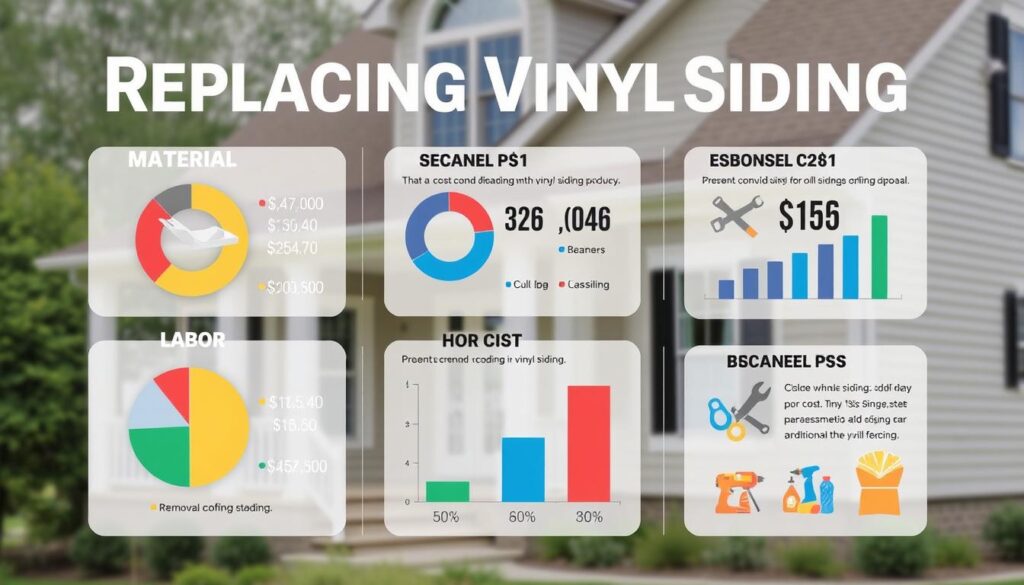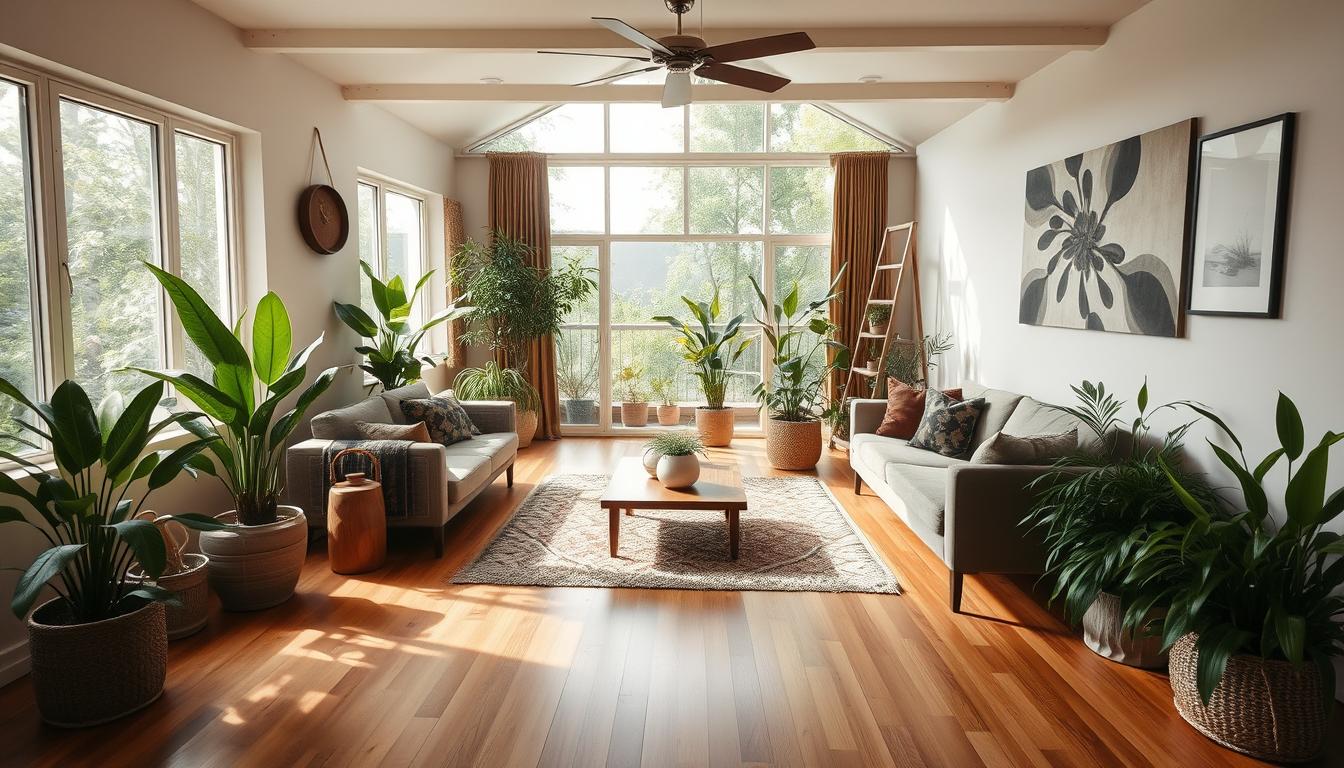Getting new vinyl siding can make your home look better and save energy. But, it’s a big expense. Knowing what affects the cost is key. This guide covers the average cost, what affects it, and the benefits of a new look.

Key Takeaways
- Replacing vinyl siding can significantly enhance a home’s curb appeal and energy efficiency.
- The average cost range for vinyl siding replacement projects varies, depending on factors such as house size, material quality, and regional labor costs.
- Understanding the factors that influence siding replacement costs can help homeowners budget effectively and make informed decisions.
- Investing in high-quality vinyl siding can yield long-term energy savings and increased property value.
- Professional installation is often recommended for optimal results, but DIY options are available for cost-conscious homeowners.
Understanding Vinyl Siding Replacement Basics
Vinyl siding is a favorite for home exteriors because it’s durable, easy to care for, and can be customized. But, it will need to be replaced eventually. Knowing the basics helps homeowners make smart choices.
Types of Vinyl Siding Materials
Vinyl siding comes in many styles and thicknesses. Standard vinyl is affordable, while insulated vinyl is better for energy and sound. You can pick from lots of colors and textures to match your home’s look.
Common Signs You Need Replacement
Worn, cracked, or faded vinyl siding hurts your home’s look and might mean bigger problems. Look out for these signs:
- Visible cracks or warping
- Discoloration or fading
- Loose or missing panels
- Increased energy bills due to poor insulation
Benefits of Replacing Old Siding
Getting new vinyl siding brings many advantages, including:
- Improved energy efficiency and lower bills
- Better curb appeal and home value
- Longer-lasting durability and less upkeep
- Enhanced sound insulation and quieter home
Learning about vinyl siding replacement helps homeowners upgrade their home’s look. They get to enjoy the benefits of a modern, fresh exterior for years to come.
Average Cost Range for Vinyl Siding Replacement Projects
Replacing your home’s vinyl siding is a big deal. It’s key to know the typical costs to plan your budget well. The average siding replacement cost changes based on your home’s size, siding quality, and where you live.
For a standard-sized single-family home (2,000-2,500 square feet), the average vinyl siding price is between $10,000 and $20,000. This includes the siding, labor, and any prep or repairs needed.
| Home Size | Average Siding Replacement Cost |
|---|---|
| 1,500 sq. ft. | $8,000 – $15,000 |
| 2,000 sq. ft. | $10,000 – $20,000 |
| 2,500 sq. ft. | $12,000 – $25,000 |
Keep in mind, these are national averages. Your local siding replacement cost might differ. Local labor rates, material availability, and your home’s design complexity can affect the final cost.
“The cost of vinyl siding replacement can be a significant investment, but it’s an essential home improvement that can enhance your property’s curb appeal and energy efficiency. By understanding the average cost ranges, you can better plan and budget for your siding project.”
Factors That Influence Vinyl Siding Replacement Costs
Replacing vinyl siding involves several key factors that affect the cost. Knowing these can help you plan and budget your home improvement.
House Size and Layout Considerations
The size of your home is a big factor in siding replacement costs. Bigger homes need more materials and labor, making them more expensive. The design of your home also plays a role. Homes with complex designs or unique features may cost more due to extra time and specialized techniques.
Labor Costs by Region
The cost of labor can vary by region. Areas with higher labor rates, like big cities or coastal areas, tend to have pricier projects. Knowing the labor rates in your area can help you estimate the labor costs for your siding project.
Material Quality and Style Options
The type and quality of vinyl siding you choose also affects the cost. Premium siding options are more expensive, while standard siding is cheaper. The design of the siding can also impact the price, with more detailed or custom designs costing more.
Understanding these siding cost factors, home size impact, and regional labor costs helps homeowners plan better. This way, they can make informed decisions for their vinyl siding replacement projects.
How Much It Cost to Replace Vinyl Siding: Complete Breakdown
Replacing your home’s vinyl siding can cost a lot, depending on several factors. Let’s break down the costs of vinyl siding replacement to understand the project better.
The main costs for replacing vinyl siding include:
- Siding Materials – The cost depends on the type, quality, and amount of siding. Prices range from $2 to $8 per square foot.
- Labor Costs – Hiring professionals can cost 50-60% of the total, from $3 to $8 per square foot.
- Disposal Fees – Getting rid of the old siding adds $500 to $1,000 to the bill.
- Additional Expenses – Costs for wall repairs, trim work, and permits can also increase the total cost.
For example, a 1,500 square foot home might cost between $3,000 and $12,000 for materials. Labor could add $4,500 to $12,000. Disposal fees are $500 to $1,000. So, the total could be $8,000 to $25,000 or more, depending on the job’s details.

The siding cost breakdown, vinyl replacement expenses, and itemized siding costs vary by home and material quality. Knowing these details helps you plan and budget for a vinyl siding replacement.
Labor Costs and Installation Timeline
Replacing your home’s vinyl siding involves labor costs and a timeline. Choosing between professional installation and DIY affects the price and project duration.
Professional vs DIY Installation
Professional siding contractors cost more upfront but ensure a smooth installation. They have the skills, tools, and safety measures for a quick job. DIY installation saves money but requires a lot of time and might need special equipment.
Time Requirements for Completion
The siding replacement timeline depends on the home size, project complexity, and installation method. Professionals can finish a standard home in 3-5 days. DIY projects, however, can take weeks or months, depending on the homeowner’s skills and time.
Additional Labor Considerations
Other labor factors include specialized skills or equipment needs. Some siding materials need a carpenter’s expertise or power tools, increasing costs. Disposing of old siding also adds to the timeline and budget, needing professional waste management.
When planning your siding replacement, weigh the pros and cons of professional versus DIY installation. Consider the financial and time implications. Understanding labor-related factors helps make a decision that fits your budget, timeline, and preferences.
Material Quality and Brand Comparison
Choosing the right vinyl siding for your home is crucial. The quality and brand you pick affect the cost and how long it lasts. Let’s explore the top vinyl siding brands and what makes them stand out.
CertainTeed, Alside, and Mastic Home Exteriors are among the most trusted names. They focus on quality, innovation, and offer many styles and colors.
| Brand | Durability | Warranty | Price Range (per sq. ft.) |
|---|---|---|---|
| CertainTeed | Excellent | Lifetime Limited | $3.50 – $6.00 |
| Alside | Very Good | Lifetime Limited | $2.75 – $5.25 |
| Mastic Home Exteriors | Excellent | Lifetime Limited | $3.25 – $5.75 |
When looking at vinyl siding brands, consider the material’s thickness and durability. Thicker siding is better at withstanding weather and damage.
In a siding quality comparison, CertainTeed and Mastic Home Exteriors lead in quality and durability. Alside is a bit more affordable but still offers great performance. Think about your budget and needs to choose the best siding materials for your home.

“The quality of the vinyl siding you choose can have a lasting impact on the appearance and protection of your home. Investing in a reputable brand like CertainTeed or Mastic can provide peace of mind and long-term value.”
Hidden Costs and Additional Expenses
When planning a vinyl siding replacement, remember it’s not just about the material and labor. There are hidden costs that can greatly affect your budget.
Removal of Old Siding
Removing your old vinyl siding is a big expense. It’s a tough job that might need special tools. This can cost from a few hundred to over a thousand dollars, depending on your home’s condition and how easy it is to access.
Repairs and Preparations
Before putting on new siding, you might need to fix your home’s structure. This includes replacing damaged sheathing and fixing wall cavities. These steps are key for a good and lasting siding job.
Disposal Fees
After removing the old siding, you’ll face disposal costs. These can vary based on local rules and how much material you have. Disposal fees can add hundreds to thousands of dollars to your budget.
Knowing about these hidden costs helps you plan better. This way, you can budget for a complete vinyl siding replacement that meets your needs.
Energy Efficiency and Long-term Savings
Choosing quality vinyl siding can save you money in the long run. It makes your home more energy-efficient. This means you’ll use less energy for heating and cooling.
With energy-efficient siding, your energy bills will go down. This can lead to big savings over time. Plus, it can make your HVAC system last longer, saving you even more money.
Energy-efficient siding is also good for the planet. It uses less energy, which is better for the environment. So, you’re making a smart choice for your wallet and the Earth.
FAQ
What are the different types of vinyl siding materials?
Vinyl siding comes in two main types: standard and insulated. Standard siding is the most common and affordable. Insulated siding offers better thermal benefits and can save on energy costs.
What are the common signs that indicate it’s time to replace old vinyl siding?
Signs you need new siding include warping, cracking, fading, and moisture issues. If your siding is over 20 years old or damaged, it’s time for a new one.
What are the benefits of replacing old vinyl siding?
New siding boosts energy efficiency, curb appeal, and home value. It also protects your home better and prevents moisture damage.
What is the average cost range for vinyl siding replacement projects?
Vinyl siding replacement costs range from $5,000 to $20,000 or more. Costs depend on your home’s size, siding quality, and local labor prices.
What factors influence the cost of vinyl siding replacement?
Costs are influenced by your home’s size, siding quality, and local labor. Any repairs or prep work also add to the cost.
What is the typical breakdown of vinyl siding replacement costs?
Costs include siding materials, installation labor, and disposal fees. Additional expenses like repairs or tools can also apply.
What are the differences between professional and DIY vinyl siding installation?
Pros install siding better and faster but cost more. DIY saves money but needs skills and tools. DIY may lack quality and warranty.
How long does a typical vinyl siding replacement project take to complete?
Projects take 1-2 weeks for a full house. Weather, access, and repairs can affect the time.
How do different vinyl siding brands and material quality compare?
Many brands offer various qualities and prices. Research to find the best match for your budget and style.
What are some of the hidden costs and additional expenses to consider for a vinyl siding replacement project?
Hidden costs include old siding removal, repairs, and specialized tools. Include these in your budget.
How can new vinyl siding improve energy efficiency and lead to long-term savings?
Energy-efficient siding reduces energy costs over time. It keeps your home warm in winter and cool in summer, saving money.



